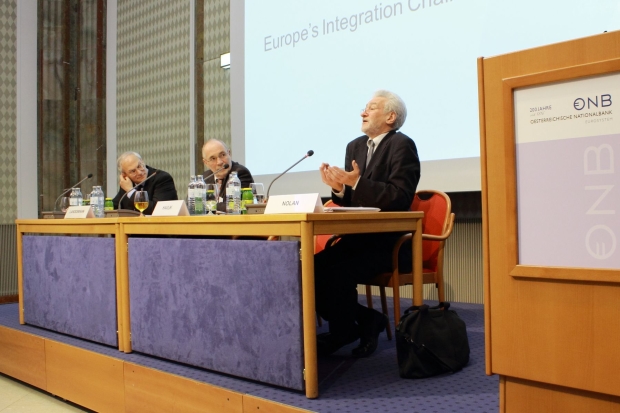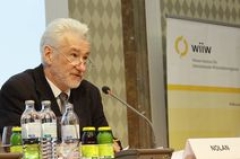Along the Silk Road
26 April 2016
Peter Nolan and Peter Havlik, two country experts for China and Russia, respectively, present different perspectives on China’s Silk Road Strategy.
A seminar note by Julia Grübler.
In today’s globalised world, the European Union’s economic performance is everything but solely shaped by its own policies. It is strongly interlinked with developments in other parts of the world, especially major emerging economies such as China and Russia. The gradual economic slowdown of the Chinese economy has spillovers to other economies through the channels of trade, weaker commodity prices and increasing volatility in financial markets. Relations of the EU with Russia are currently suffering from geopolitical tensions, economic sanctions as well as a general feeling of uncertainty. At the wiiw Spring Seminar, Peter Nolan, Chong Hua Professor, Cambridge University shed light on the history of China’s ties with countries along the Silk Road and outlined the challenges of China’s current Silk Road investment plans. Peter Havlik, wiiw Senior economist in turn elaborated the topic by taking the perspective of Russia.
Keynote speech by Professor Nolan on the history of China and the Silk Road
The Silk Road by land connected regions of former Turkestan – including present-day Turkmenistan, Kazakhstan, Uzbekistan, Kyrgyzstan and Xinjiang (or Chinese Turkestan) – with Mongolia, Tibet and China. Through trade, Buddhism – which originated in the north of India – spread to China and became the dominant belief system in Asia. Buddhism gained so much power, that in the 840s the Taoist Emperor of China initiated an anti-Buddhist campaign, leading to the destruction of monuments, confiscation of property, and sending monks and nuns to lay life. Still, even today Buddhism is an important part of Chinese philosophy, together with Taoism and Confucianism. It also exposes the deep link between China, India and Japan. Later on, Islam spread into Central Asia via trading routes and had a strong impact on China. Professor Nolan stressed that we ‘ought to know’ that in Turkestan – in regions along the Silk Road – intellectual progress was stimulated through exchanges, not only of goods but also and most importantly of ideas, leading to the age of Enlightenment in Central Asia between the 8th and 15h century, while Europe was still vegetating in the dark ages. The following centuries were marked by the Russian expansion to the East. Thus, China and its neighbouring regions share a complex common history, characterised by trade, the cultural heritage of both Confucianism, Buddhism and Islam, and later on by the western expansion.
Trade across the South China Sea took place long before the Roman Empire even existed. The Silk Road by sea, reaching from China to as far as East Africa, dates back to medieval times as shown by artefacts of Chinese Porcelain in Africa and Europe. Trade of Chinese Porcelain was accompanied by trade in silk and eventually tea. Trade in goods and ideas has also shaped Chinese maritime technologies, improving the safety of travelling (e.g. through watertight compartments, which were introduced by Europeans much later) and making maritime navigation easier.
Throughout history, China did not attempt to establish colonies. It commissioned expeditions to gather information and produce maps – where, until today, the South Chinese Sea (including disputed islands) has been shown as a part of Chinese territory. For more than 2000 years China has been the centre of Asia, until Western colonialism spread, starting with Russia in the 16th century moving through Siberia to Kazakhstan and Mongolia. Following the Portuguese, the British conquered South-East Asia, the Dutch colonised Indonesia and later on the US Americans took control over the Philippines, and the French fought a war in Vietnam. In 1989, eventually, the United Nations Convention on the Law of the Sea established the concept of exclusive economic zones, stretching 200 nautical miles from the coast. China’s undisputed economic zones amount to 900,000 km2. If China won all the ongoing related disputes they would still be less than 3 million km2. By contrast, the economic zones of France stretch over 10.7 million km2, those of the USA over 9.8 million. Russia’s economic zones count 6.7 million km2, followed by Britain with 6.0 million km2, New Zealand with 3.3 million km2 and Australia with 2.6 million km2. Therefore, the size of today’s exclusive economic zones of former colonisers amounts to about 31 million km2 and is thus ten times as big as the greatest possible maritime area assigned to China, rendering the concept of exclusive economic zones in Peter Nolan’s view questionable and unfair.
From the beginning, Professor Nolan mitigated the fear that China would benefit over-proportionately from infrastructure investment and the economic expansion along the Silk Road. As an illustrative example he chose the newly built Shanghai tower. From the outside, it is an impressive symbol of China’s advancement and power. Yet, the most sophisticated pieces of technology – e.g. incorporated in high speed elevators – are foreign products in the hands of western multinationals. In the case of high speed elevators, he mentioned Mitsubishi Electric, the Schindler Group and ThyssenKrupp. Investments along the Silk Road could therefore be interpreted as win-win-situation between China (investors), the US and the EU (major technology suppliers) and the countries along the Silk Road that the investments are directed to.
Peter Havlik on the Silk Road and Eurasian Integration
Peter Havlik shed light on the current discussions surrounding the Silk Road Strategy from Russia’s point of view. The Russian-led post-Soviet integration process started about 20 years ago and brought forth the Eurasian Economic Union (EAEU), established in January 2015 by Armenia, Belarus, Kazakhstan, Kyrgyzstan and Russia. The EAEU is dominated by Russia: it accounts for three quarters of total GDP of this region. Yet, taking perspective of a Wider Eurasia, stretching from Lisbon over Vladivostok to Shanghai, Russia’s share in the combined GDP of this area would amount to just 5% and is dwarfed by China’s 30% of total GDP.
Russia has been “stuck in transition” even before the Ukraine crisis escalated. In addition, the collapse of energy prices diminished export revenues; devaluation of the Rouble decimated imports. Both export products as well as export destinations are only little diversified. While trade relations between the EU and China are characterised by intra-industry trade in manufacturing, the situation is very much different for Russia, for which oil and gas pipelines are key to exports, being vulnerable to volatile commodity prices. Russian imports mainly consist of machinery, electrical equipment and consumer goods. As of 2014, China was equally important as Germany as an export destination market for Russia (each accounting for about 7.5% of total Russian exports), while China constituted the single largest source of Russian imports with a share of 17.8% (compared to Germany with 11.5%).
An expansion of Russian oil and gas pipelines to the East as well as rail cargo transit routes across the Eurasian continent require major investments and face numerous logistic obstacles (e.g. related to incompatible rail gauges and financing bottlenecks). Russia’s own resources to invest are scarce, particularly due to international sanctions and low energy prices. Funds to realise infrastructure investments could, however, stem from the Eurasian Development Bank (providing USD 1 billion credit for road construction in Kazakhstan, Armenia, Kyrgyzstan and Tajikistan), the Asian Infrastructure Investment Bank (up to USD 100 billion) and the Chinese Silk Road Fund (USD 40 billion).
Peter Havlik distinguished potential effects of the Silk Road Strategy along different time horizons and regional perspectives: in the short run it could help Russia to diversify export markets, while China could economically develop the restive region of western Xinjiang. Geopolitically, both Russia and China aim to counter US-led TPP and TTIP global trade deals. Although China’s 16+1 investment initiative towards the Central Eastern and South Eastern European (CESEE) countries so far has a largely symbolic character, a closer integration of currently competing blocs – namely the enlarged EU and the EAEU – and China bears the potential of boosting trade, investment and growth in the wider Eurasian continent and in the long run could also have geopolitical implications, sparing Ukraine and other Eastern Partnership countries from making impossible ‘either/or’ integration choices.



